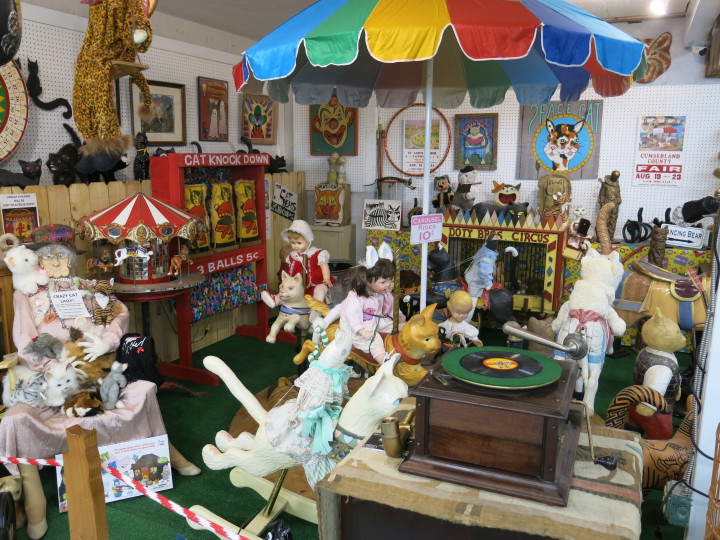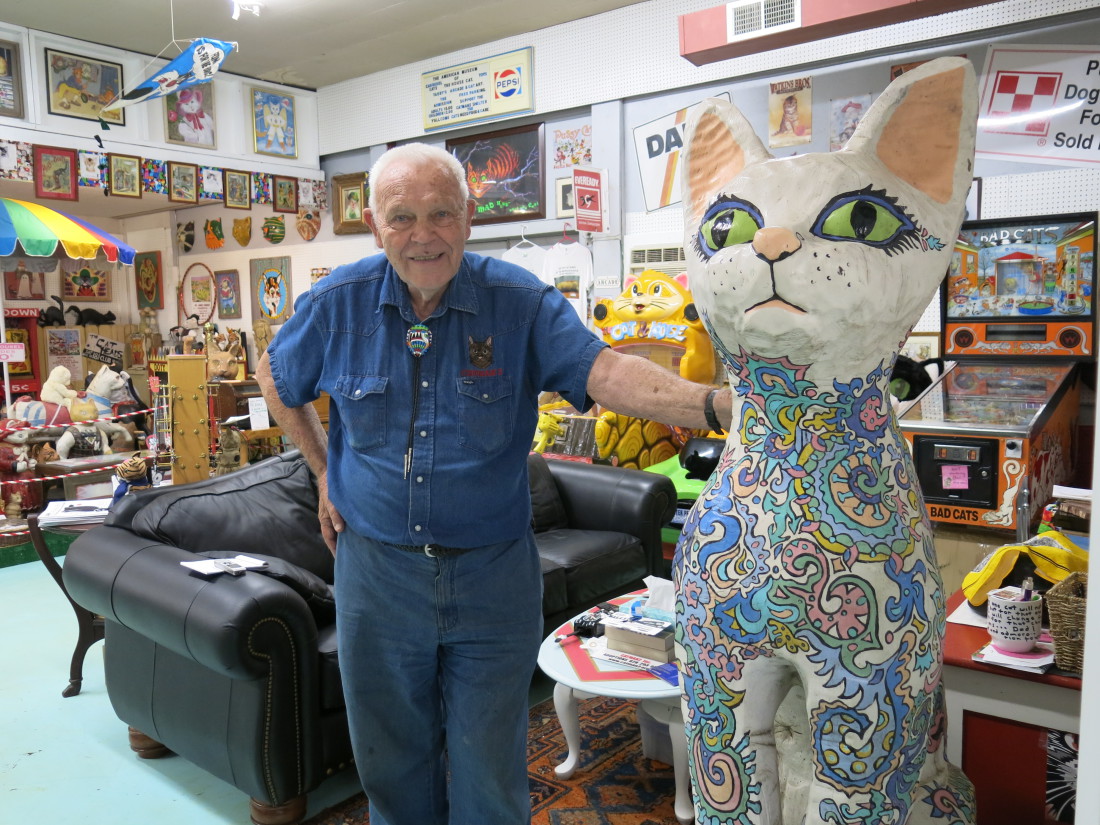SYLVA, N.C.— Julie Spiro, executive director of the Jackson County Chamber of Commerce and Visitor Center, remembers the anticipation before the American Museum of the House Cat opened last spring. “People were curious,” she says. “What would it be? What would it contain?”
Its founder, Harold Sims, was no stranger to the community, nor was his dedication to the four-legged creature any secret. Since 2002, Sims and his wife, Kay, have operated Catman2, a nonprofit, no-cage, no-kill shelter in Cullowhee. “He’s well-known for crusading for cats, which is not a common cause,” says Nick Breedlove, director of Jackson County’s Tourism Development Authority. “People really appreciate the work he’s doing.”
Yet when it came to his concept for the museum, Sims says a lot of people — including his wife — thought he was crazy. For the past 30 years, the 82-year-old former biology professor has been collecting cat-related memorabilia. When space became available inside the Old-School House Antique Mall in Dillsboro, Sims pounced on the opportunity. The timing, he says, couldn’t have been better. Space was becoming a serious problem: “I had all this stuff stored in the cat shelter, in my house, the basement [and] a shed I had outside.”
‘A sense of fascination’
On April 1, when the American Museum of the House Cat opened to the public, Sims says a line formed out the door. Since that time, he adds, the museum has welcomed more than 4,000 visitors: “We’ve got people coming in here from Germany; Russia; the Netherlands; Austria; Knoxville, Tenn.”
The items on display inside the 1,000-square-foot museum combine the quirky and the kitsch with the morbid and the mysterious. In its front room, framed paintings, cat clocks and old tin advertisements decorate the white pegboard walls. Arcade games, an in-house merry-go-round and glass-covered shelf casings lined with stuffed animals, wind-up dolls, kitty banks and squeeze toys make up the rest.
“It brings a sense of fascination,” says Breedlove. “You really don’t expect there to be that many cat-related items. And then suddenly you’re looking around at every different piece in the collection for the better part of half an hour.”
A complex history
Sims offers guests guided tours, providing anecdotes and impromptu history lessons throughout the visit. A series of 19th-century tintype photographs, for example, leads to a brief conversation about Mathew B. Brady, one of the country’s earliest photographers, best-known for his Civil War images.

Meanwhile, in the museum’s backroom, some of Sims’ most prized possessions are on display. A mummified cat — which Sims believes dates to 330 B.C. — sits behind a glass case. The Egyptians, he explains, worshipped the cat. Later on, Sims continues, cats were believed to be vessels that carried the human spirit into the next world. “That’s when they had the cat mummies coming up,” he says.
The cat’s lofty position, however, wouldn’t last. In medieval Europe, the creature was vilified through its association with witches and heretics. In Belgium, Sims says, an annual festival (Kattenstoet) involved the townspeople hurling cats from the church’s belfry. To this day, he adds, the festival is still celebrated, although stuffed animals have replaced actual cats.
These unscripted history lessons cross oceans just as easily as they do centuries — from the bubonic plague to 20th-century American advertising, from the history of cat food to the advent of cat litter. “Once you step in there, you’re just in awe,” says Breedlove. “Whether you like cats or not, whether you intended to go there or not, or just saw it alongside the road, it’s one of those places that you’ll talk about and tell others.”
The good fight
The museum itself is an extension of Catman2. Proceeds from admission as well as merchandise sales go toward the no-kill shelter. Since opening Catman2 in 2002, the nonprofit has found homes for more than 3,000 cats. All felines that enter the shelter are spayed and neutered. The organization also administers vaccinations for rabies and distemper.
“When you want to have something happen in your life, you have to dream it first,” says Sims. “I had a dream that I wanted to have the cat shelter. Then I set some goals.”
The same is true of the museum, he adds. But now that it too has been realized, Sims is on to the next goal. “Right now I’m dreaming about the open shelter [as a model] for all shelters,” he says. “No more cages.”
Don Adams, Jackson County manager, notes that Sims has shared these ideas and concepts with him. The county, Adams says, is in the process of bringing back an advisory board concerning a new shelter. “We have money set aside to build a new animal rescue center,” he continues. “What needs to happen is when we develop the programming for that, [Sims’ concepts] need to be part of the overall conversation.”
Adams notes, however, there is no set date for the committee’s relaunch. He also recognizes that the development of the new shelter has taken longer than some in the community would like. But this, he says, is why individuals like Sims are so crucial: “The work that he does and the efforts that he puts in, from a county operation standpoint, is of great benefit to our community.”
Still, Sims has his concerns about the future of his organization. “I’m 82 years old,” he says. “If I was not here, who would take care of the museum? The shelter? There’s no plan I can think of. I just hope somebody will come along before I die and say, ‘This is something we need.’”
In the meantime, Sims continues to share his vision and hope with visitors to the American Museum of the House Cat. “There are no two cats alike,” he says. “To me, to kill a cat would be like tearing up the ‘Mona Lisa.’ It’s a work of art that is one of a kind — you can’t ever create it again the same way.”



Before you comment
The comments section is here to provide a platform for civil dialogue on the issues we face together as a local community. Xpress is committed to offering this platform for all voices, but when the tone of the discussion gets nasty or strays off topic, we believe many people choose not to participate. Xpress editors are determined to moderate comments to ensure a constructive interchange is maintained. All comments judged not to be in keeping with the spirit of civil discourse will be removed and repeat violators will be banned. See here for our terms of service. Thank you for being part of this effort to promote respectful discussion.